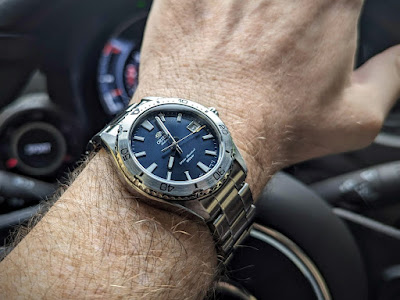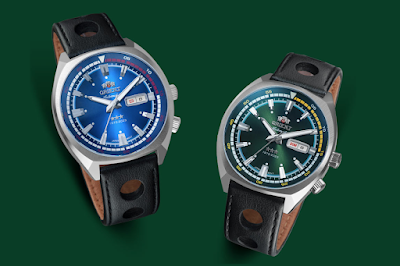Orient's Mako family of diver-style watches is among the most important
product lines in the brand's current and historical offerings. For almost 20
years, this group of models (starting with the old Mako and Ray watches with caliber
46, continuing with Mako II and Kamasu
with cal. F6, and now "Mako III" range) has provided buyers with sports
watches that are entry-level yet reliable, well made and respectable.
However wearable and popular Mako watches are at the current 42mm size,
the demand for smaller watches has surged in recent years to a point where
Orient obviously had to take note – and they did, in the form of the recently
announced "Mako 40mm".
Here at the blog we also took note and wasted no time getting our hands
on one of these babies, eager to see how worthy the newcomer is of wearing the
Mako badge… so please say hello to Orient reference RA-AC0Q02L – blue dial, stainless
steel, diver-design watch, aka Mako 40mm.
How It Looks
There is an undeniable appeal to all-steel designs. The new Mako proves
this with the combination of steel case, bezel and bracelet – no plating, no
bezel inserts, just using different finishing techniques to sculpt the metal. A
bit of matte brushing here, a sparkle of smooth polish there, will get the job
done if executed properly. And Orient definitely know how to make a good
looking piece of metal for the price.
The dial looks practically black in low light, but reveals its blueness in
the sunlight. The color is not entirely matte and not completely sunburst – rather,
it is a mixture of both, a very pleasant combination often used by Orient.
One might argue that this reference represents the best of the new Mako:
the blue dial works great with steel, and it's almost as versatile as the black
dial version but with the added flash of color. The white dial version might come
on as slightly more elegant. The purple and salmon dials can be good options if
you already have a dark dial sports watch and looking for something a bit more
playful, though their appeal might not be as long-lasting as this dark blue.
The dial layout is simple but well thought-out. All elements are nicely
proportioned, and should work well even for the most nitpicking watch aficionados
who like to complain about a hand being too short or a marker being out of
place. It's just a nice looking dial.
Unlike Mako models, the smaller diameter here got Orient to ditch the
old day-and-date combination in favor of just a date window. A very sensible
choice, if you ask me, resulting in a cleaner looking dial.
Note the markers are somewhat reminiscent of the 1964
diver's first edition, as is the steel bezel; they all seem a little
vintage-flavored. The hands are different from both the Mako's and vintage
divers; they are squared-off and semi-skeletonized, and contribute to the clean
look.
Overall finishing, however, is very much like the Mako 3 and Kamasu. You
get very subtle circular finishing on the lug tops, and on the bezel, while the
sides of the case are polished; likewise, the bracelet is brushed on top and
polished on the sides. Also similar to the Mako are the two dolphins swimming
on the case back.
Fans are expected to compare the new Mako with its older siblings and
ask whether it retains the charm of the 42mm Mako. I would say, this new watch sure
has a charm, but it is a different one. The smaller, more compact, all-steel
case somehow reminds me of certain German tool watches (and yes, it also
personally reminds me of my blue-dial
world timer, in a good way).
It's not all flawless, though, and the new watch has a certain peculiar
"bug" that appears on all dial versions, and can be seen even in the
catalog pictures: the 26 minute marker is too close to 25, and the 33 minute marker
is ever so slightly closer to 32 than to 34. Why is that? Is there an
explanation? Is that a secret message to aliens, or is 2633 the year the world
will end (Oh dear, I actually Googled and found this).
It's one of those things you won't immediately notice, but once you have… you
know. Hopefully Orient should get this fixed soon, rendering the early
production batches collector's items…
How It Wears
Since size is supposedly the new Mako's highlight, let's first talk
about dimensions. Indeed it is smaller than older models by roughly 2 millimeters
– reducing case diameter from 41.8 to 39.9mm, to be precise.
However, the new model is only 0.3mm shorter than the larger versions,
at 46.5mm lug to lug, vs 46.8mm. This means actual wearability is very similar
to Mako 2/3 or Kamasu. That's not a bad thing, as these all work very well for
most wrist sizes, hence their popularity. It's just that the new model has
longer lugs, relative to its width, than the old Mako.
The new and old Mako even weigh about the same (165g, of the new model vs.
the Mako 3/Kamasu's 169g) and are both 12.8mm thick, so the size difference has
more to do with how the watch looks, than how it wears.
The bracelet is very similar to the old Mako's – except being 2mm
narrower, as lug width here is 20mm. You get the same style of clasp, same
hollow end-links, and while not being remotely luxurious Orient seem to stick
to their successful formula here – offering good value for money with a bracelet
that is simple but feels robust enough to match the tool-watch image.
All in all, the watch is very comfortable to wear, there's no hair
pulling from the bracelet or pinching from the clasp, and it's got just enough
heft to be felt but not be a burden on the wrist.
How It Functions
The beating heart of the Mako 40mm is Orient's caliber F6722, an
automatic movement that is similar to the Mako 42's F6922 except for the
omission of the day wheel. It features hand-winding and hacking, about 40 hours
of power reserve, and the same stated accuracy of +25/-15 seconds per day. The
watch reviewed provided a +11 seconds per day accuracy, with very little
deviation between wearing and off-wrist time, which is quite acceptable for
this price point and type of watch.
The relative weakness of the Kamasu I once reviewed was the crown, so it
was interesting to see what has changed here.
Despite being a smaller watch, the crown is about the same size, though
the crown-guard of the larger model makes it a little hard to make a direct
comparison. The absence of a crown guard on the new Mako should have allowed
for an easier grip on the crown, but somehow it does not feel this way, and
operating the small crown is still tricky – particularly when trying to screw
it into position.
Winding, however, does feel a little smoother compared to the Kamasu's
rather gritty operation, and the crown is almost wobble-free, so there are also
some improvements. All things considered, crown operation is still a relative
weakness.
Bezel operation is on the hard side, harder than on the Kamasu –
possibly because of the small diameter. But, it does offer accurate operation
with almost no back-play, certainly better than most watches in this price
range.
Legibility is excellent – the markers are big and clear, as are the
hands, with sufficient lume to enable reading the time when it gets dark. It is
not an all-night kind of crazy lume you might get from professional dive
watches, but it is still pretty good. And while the sapphire crystal here does
not feature the excellent anti-reflective coating found on most Orient Star
models, the clarity and contrast of the dial layout make reading the time easy
through most reflections.
Note that unlike most Orient diver watches (except the Kanno) there is
no lume on the bezel, and the dot at 12 is just steel. As this is not intended
as a true diver's watch, instead aiming for dive watch styling, this is
not a major drawback, and if you see the bezel more as a decoration than a
functional component it can actually be an advantage.
The Bottom Line
The new Mako 40 is not just a "smaller Mako". The difference
in styling, and even more so in the wearing experience, is actually more noticeable
than the difference in size. As such, it presents not just a compelling
alternative to the 42mm model, but even a complementary option. This also makes it as strong a competitor in the entry-level automatic sports watch market as
any of its Orient forerunners.
As a package, it's pretty convincing, in the functional-mechanical
aspect as well as stylistically. Yes, it has its imperfections – the crown
operation is still not fully satisfactory, and there's that weird
minute-markers thing. But overall, you get a good looking watch that's as dependable,
comfortable and well-made as we've come to expect from Orient. It really is
enjoyable enough on the wrist to make one forget the downsides – most of the
time.
Official pricing is about 5% above 42mm Mako/Kamasu models, and while
the only reason that comes to mind is the steel bezel, it is a fairly minimal
difference and street prices are now dropping to more realistic levels anyway;
I'm seeing the Mako 40 now selling anywhere between 300-400 USD. It takes a
while for a new watch to find its place on the supply/demand diagram, but I'm
guessing it should soon glide toward the 300 mark, as older 42mm versions stay
not to far below it.
So – well done Orient, get those minute markers fixed, and don't forget
to give us a yellow-dial version next year, to celebrate the first Mako's 20th
anniversary!
The blog would like to thank Orient – Epson Europe for providing us this Mako 40mm for review.



























